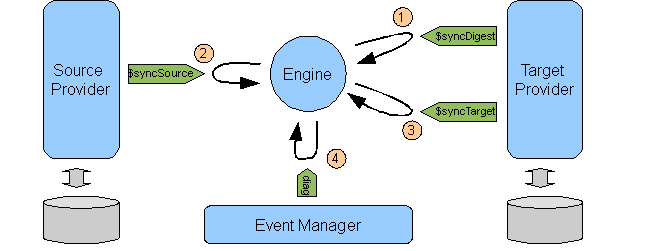3.2 Reference Architecture
The following diagram shows how components interact with each other in a catch up synchronization pass:

The process unfolds as follows:
-
The engine gets the target digest.
-
The engine sends the target digest to the source. The source uses the two digests (its own and the target one) to select the resources that need to be transferred to the target (see Detecting Changes with Digest section). The source returns a synchronization feed to the engine.
-
The engine sends the synchronization feed to the target. The synchronization feed is a batch of create/update/delete instructions that the target provider executes to bring its data store in sync. The synchronization feed also contains the two digests that have been used to select resources on the source side. The target uses these digests to detect and resolve conflicts (see Conflict Handling with Digest section). When the batch has been processed, the target updates its digest to reflect the fact that the changes have been applied. The target returns diagnostic information about the success/failure of the operations that have been submitted.
-
The engine sends the diagnostics that it just received to the event manager. The event manager logs them and alerts users if configured to do so.
The synchronization feed is broken in pages (using the SData paging protocol). So the engine repeats steps 2, 3 and 4 on every page of the feed.
This architecture has some interesting properties:
-
All the communications are based on HTTP and URLs. As a result, the engine can be run from anywhere, as long as it can access the URLs (the engine is a service consumer that connects to several providers).
-
The intelligence is in the endpoints and the messages, not in the engine. The engine is just a simple process that passes messages around. It needs to know the URLs of the 3 participants (source, target and event manager) but it only needs to know very little about the messages that are exchanged (it just needs to detect the end of the batch to stop its loop). Implementing an engine is a rather trivial task (the same cannot be said of endpoints).
-
The engine is stateless. It can be packaged as a simple object that gets instantiated at the beginning of every pass. The URLs must be configured before starting the synchronization pass. Once the pass has been completed, the engine object can be deleted. So, the engine is not tied to a particular location and the synchronization passes can be run from different places. All that is required is that the engine knows the URLs and this rather a configuration/repository issue than a synchronization issue per se.


